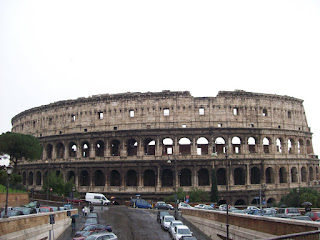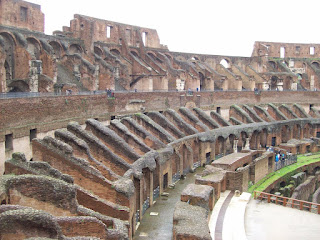
The Forum was the center of the Roman Republic. This was where the Senate and the republican government began. This was a gathering place and a place for justice and worship. And probably for all the latest fashions and quality sporting goods.

The three arched areas in the background are part of the Basilica of Maxentius (and Constantine). It was the largest building in the Roman Forum. It was not built until after 300 AD. Yes, those are groin vaults.

Here's where some signage would have been nice. I have no idea what these might have been. I'm going to say that it was a Taco Bell built in 237 AD by Nautius Maximus. Prove me wrong.

Look at all the rubbish strewn along the path. Shame really.

Does anyone know what this structure was? There's a prize for the correct answer.

On the left are the remains of the Temple of Castor and Pollux, and on the right is the Temple of Vesta, I believe.

This whole area, between the Capitoline and Palatine hills, was originally a grassy wetland. A covered sewer system was built in the 7th century BC to drain the water to the Tiber.

Castor and Pollux again.

and again. Built in 495 BC, it was.

This was the Temple of Saturn. It is supposed to be the oldest surviving structure in the area. It was built between 501 and 498 BC.

Ewww. There are basilica remains everywhere.

Here is the Arch of Septimius Severus. It was finished around 203 AD.

The triumphal arch commemorated the victories of Septemius Severus and his sons Caracalla and Geta over the Parthians. After poppa died, Caracalla had Geta assassinated.
The Capitoline Museum is the large building in the background. The bottom of it (with the three arched openings, one of which you can see here) was the Tabularium, the official records office of ancient Rome. When we were in Rome before this I took many pictures of these same temple remains from the Tabularium.

On the left is the Temple of Saturn again. And on the right is the Temple of Vespasian and Titus. Say, aren't those the fellas that built the Colosseum? Why yes, they are.

Sarah peruses the mess the Romans made. To the left of the Temple of Saturn are the remains of the Basilica Julia, which was begun in 46 BC by Julius Caesar and finished by his adopted heir Augustus. It was built with with the spoils of the Gallic War. It contained law courts, shops, government offices, and space for banking.
Well, I've had enough of Rome. I'm moving on to a new city.






































